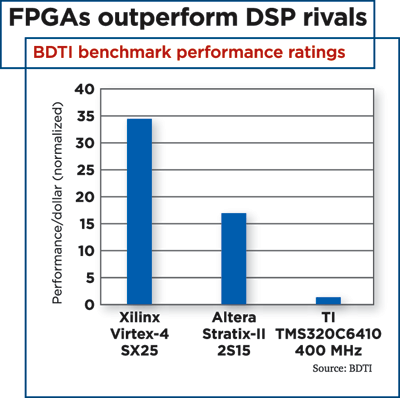FPGAs can outperform DSPs, says study
By Mark LaPedus
San Jose, Calif. -- For years, systems designers in high-end communications have faced a series of tough and complex chip choices among ASSPs, ASICs, DSPs, FPGAs and other devices.
While a number of cost and performance trade-offs are associated with those chip technologies, FPGA vendors have long argued that their respective devices have several advantages over complex and costly ASICs--faster time-to-market and more design flexibility, for example. However, FPGA cost/performance metrics have generally been perceived as weak compared with digital signal processors--until now.
FPGAs may now have a cost/performance advantage over standalone DSPs in a "significant class of DSP applications," according to a new and controversial benchmarking study from Berkeley Design Technology Inc. (BDTI).

In particular, FPGAs are better-suited than standalone DSPs "in performance-hungry applications with a lot of parallelism," such as high-end communications infrastructure equipment, said Jeff Bier, founder and president of BDTI (Berkeley, Calif.), a technology consultancy. "FPGAs will play an increasing role in DSP applications," Bier said.
FPGAs will not take over the world overnight, according to the report, which is both detailed and nuanced. Bier takes pains to stress that for many high-end telecom and other applications, FPGAs will continue to be used alongside existing devices in systems, such as application-specific standard products (ASSPs), ASICs, DSPs, general-purpose processors and other chips. But based on BDTI's study, there are also signs that FPGAs, traditionally associated with high cost, are actually less expensive than a DSP solution for certain applications in a design.
The study, dubbed "FPGAs for DSP," included tests that measured the relative performance and efficiency of select DSPs and FPGAs in high-end, "telecom oriented" tasks--based on BDTI's proprietary orthogonal frequency division multiplexing (OFDM) benchmark technology. The benchmark is designed to represent the types of signal processing found in digital subscriber line systems, cable modems and wireless products.
"When you have a performance-demanding environment like a multichannel OFDM receiver, FPGAs turned in a very good result," Bier said.
In a test--or shootout--between various "cost-effective" midrange devices, the FPGAs outperformed the DSPs by a wide margin--at least in this benchmark. In addition, Xilinx Inc.'s midrange Virtex-4 SX25 family of FPGAs also outperformed Altera Corp.'s Stratix II 2S15 family of FPGAs, as well as Texas Instruments Inc.'s TMS320C6410 line of DSPs and Freescale Semiconductor Inc.'s MSC8144 line of DSPs, according to the firm.
Benchmark results were reported in terms of the number of channels that can be supported on a particular chip and the associated cost per channel.
Bier noted that a high-performance DSP can cost anywhere from $30 to $200 and can handle perhaps four channels in the benchmark. That equates to $50 per channel at the high end. A high-end FPGA in the study, which can cost as much as $200, can implement 20 to 40 channels of the benchmark receiver (some fixed multipliers are built into the architecture and additional ones can be designed into the FPGA logic fabric). That equates to as little as $6 per channel for the FPGA, Bier noted.
A designer, then, can achieve many more multiplies at a lower clock rate (roughly 250 MHz on an FPGA). "You wind up with an order of magnitude higher throughput per second on the FPGA vs. the DSP," he said.
The results indicated that Xilinx's device had a relative rating of 34, followed by Altera with 17 and TI with 1. Freescale's results were estimated and not given a relative rating.
Surprising results
In other words, Xilinx's FPGA is 34 times more cost-effective than TI's DSP in this benchmark--which caught some analysts by surprise. "It's a shock," said analyst Satya Chillara, who follows Altera, TI, Xilinx and other chip makers for investment banking firm Pacific Growth Equities LLC (San Francisco). "On a frequency basis, I didn't think FPGAs could outperform DSPs."
Freescale (Austin, Texas) and Altera (San Jose, Calif.) declined to comment on the report. FPGA powerhouse Xilinx (San Jose) declared victory in the shootout. "When it comes to competing platforms from different FPGA companies," the performance results say it all, said Omid Tahernia, vice president and general manager of the Processing Solutions Group at Xilinx.
Tahernia also indicated that FPGAs and DSPs are still somewhat complementary in high-end systems, adding that the real battle for sockets is still between FPGAs and ASICs.
"Are we taking away share from the ASIC market? Yes, we are," Tahernia said.
- 嵌入式系统与FPGA的最新动向(05-18)
- FPGA走向硅片融合时代(07-12)
- 20nm时代,FPGA或将拔得头筹(11-30)
- 没有退路的FPGA与晶圆代工业者(01-03)
- 电源管理成为FPGA新的技术突破口(12-16)
- 数字电源为FPGA带来高效率(12-16)
